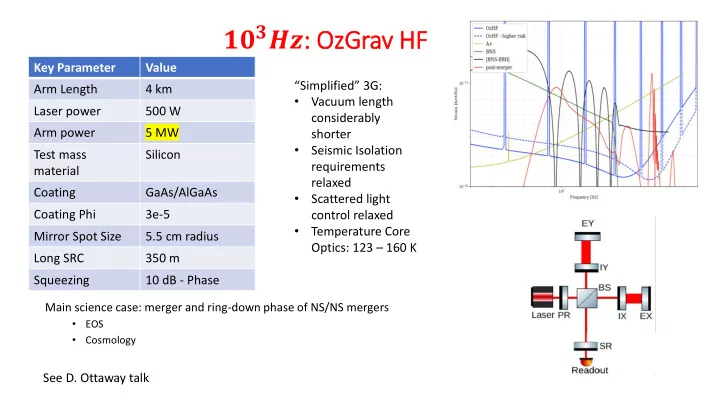

𝟐𝟏 𝟒 𝑰𝒜 : : OzGrav HF HF Key Parameter Value “Simplified” 3G: Arm Length 4 km • Vacuum length Laser power 500 W considerably Arm power 5 MW shorter • Seismic Isolation Test mass Silicon requirements material relaxed Coating GaAs/AlGaAs • Scattered light Coating Phi 3e-5 control relaxed • Temperature Core Mirror Spot Size 5.5 cm radius Optics: 123 – 160 K Long SRC 350 m Squeezing 10 dB - Phase Main science case: merger and ring-down phase of NS/NS mergers • EOS • Cosmology See D. Ottaway talk
Spherical resonant masses Schenberg 10 mK • Reconstruction of the Schenberg array components of the strain ℎ 𝑗𝑘 • High sensitivity Niobium parametric transducer • Improvement with squeezing Advanced LIGO at 10 GHz? Talk of Odylio D. Aguiar
Optic ically-levitated sensors Laser Optically-levitated particles in vacuum have very little friction – Ideal for ultrasensitive force detection • Laser intensity changed to match trap frequency to GW frequency • For a 10m cavity, h ~ 10 -22 Hz -1/2 at high frequency (100kHz) • Limited by thermal noise in sensor (not laser shot noise) → much better at high frequency!! LIGO sensitivity decreases at high frequency (laser shot noise limited ) levitated sensors improve (thermal noise limited) Geraci’s Talk
In Inverse Gertsenshtein effect etc. • Upper limits on stochastic UHF GWs with axion experiments data • PBH • At present, the magnetic conversion detectors seem to be the simplest to understand and might reach 10 -24 at 10 10 Hz. A 10 6 factor still needed. GW See Grote, Cruise
Possibilities above 1 GHz GW Effect on EMW Direction ( Fakir, Labeyrie & Bracco ) GW Effect on EMW Frequency ( Baierlein ) GW Effect on EMW Amplitude ( Zipoy ) GW Effect on Polarisation ( Cruise ) GW Resonant Effect on EMW Polarisation (Cruise ) Conversion of GW to EMW in static Magnetic Field (Gershenstein ) Conversion of GW to EMW in static Electric Field ( Lupanov ) Bulk acoustic wave resonator ( Goryachev & Tobar ) Superconducting rings/Sagnac effect ( Anandan and Chiao ) Heterodyne amplification of magnetic conversion signals ( Li ) (See Cruise’s Talk)
Today • Bulk Acoustic Wave Devices • Parametric signal amplification ( Goryachev’s talk) ( Harada’s talk) • Transducer (BAW)+Amplifier • Motivation: improve detection in (SQUID) kHz band • 1-1000 MHz. 𝑅 = 10 10 : higher • Optical spring: optomechanical than other technologies mixing of mechanic and optical • Coupling to mw & optics (R/D) modes • Losses at very low T (<1K) (R/D) • Active medium at the dark port, to • Nonlinearities (R/D) get parametric amplification • The effect can be tuned to • Several advantages, poor accuracy improve kHz sensitivity (by moving • BAW as a GW antenna there optical spring resonance) 10 −22 @100 𝑁𝐼𝑨 • Bandwidth limited by broadband SQUID noise • Moving to 20 mK
Questions • Can Fabry Perot cavities enhance the sensitivity of magnetic • It is worth to pursue the conversion detectors sufficiently? Gertsenshtein road? • Li-Baker detectors? • Cavity effect: it works with • Could other detector concepts be magnetic conversion? more relevant? • Strong enough scientific case for • Superconducting rings/Sagnac effects magnetic conversion facilities? • Bulk acoustic wave resonators • What is the value of a Hertz • …… experiment? • Laboratory sources look very difficult but they would generate controllable, predictable single frequency signals. • Use of correlations? • Difficult at high frequency. • Hopeless? • Co-located interferometers (up to 100 MHz)
Recommend
More recommend